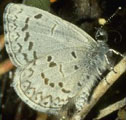Native Plants
Search for native plants by scientific name, common name or family. If you are not sure what you are looking for, try the Combination Search or our Recommended Species lists.
Viburnum dentatum
Viburnum dentatum L.
Southern Arrowwood
Caprifoliaceae (Honeysuckle Family)
Synonym(s):
USDA Symbol: vide
USDA Native Status: L48 (N)
A 6-8 ft. shrub, sometimes taller, with multiple, erect-arching stems in a loose, round habit. White, flat-topped flower clusters are followed by dark blue berries. Lustrous, dark-green foliage turns yellow to wine-red in fall. A shrub with downy twigs, coarsely toothed leaves, and flat-topped clusters of small, white flowers. Some botanists recognize two separate species for this highly variable plant, the other being northern Arrowwood (V. recognitum) with smooth twigs.
Plant Characteristics
Duration: PerennialHabit: Shrub
Leaf Retention: Deciduous
Leaf Arrangement: Opposite
Leaf Complexity: Simple
Leaf Shape: Elliptic , Ovate
Leaf Margin: Serrate
Fruit Type: Drupe
Size Notes: Many branched shrub up to about 15 feet tall, often shorter.
Leaf: Shiny dark green above, pale below.
Autumn Foliage: yes
Flower: Flowers 2-4 inches across.
Fruit: Black, Purple 1/3 inch long.
Distribution
USA: AL , AR , CT , DC , DE , FL , GA , IA , IL , IN , KY , LA , MA , MD , ME , MI , MO , MS , NC , NH , NJ , NY , OH , PA , RI , SC , TN , TX , VA , VT , WI , WVCanada: NB , ON
Native Distribution: FL to e. TX, n., especially on the Coastal Plain to MA & OH
Native Habitat: Stream banks; moist woods
Growing Conditions
Light Requirement: Sun , Part Shade , ShadeSoil Moisture: Moist
Soil pH: Acidic (pH<6.8)
Soil Description: Dry to wet, acid soils and sands.
Conditions Comments: Flood, insect and disease tolerant. Suckers freely from base and transplants well. Most soil-adaptable of the viburnums. Pest free.
Benefit
Use Wildlife: Gamebirds, songbirds and small mammals. Attracts Eastern Bluebird, Northern Flicker, Gray Catbird, and American Robin.Conspicuous Flowers: yes
Attracts: Birds , Butterflies
Larval Host: Spring Azure
Value to Beneficial Insects
Special Value to Native BeesSpecial Value to Bumble Bees
Supports Conservation Biological Control
This information was provided by the Pollinator Program at The Xerces Society for Invertebrate Conservation.
Butterflies and Moths of North America (BAMONA)
|
Spring Azure (Celastrina "ladon" )  Larval Host |
Propagation
Seed Collection: Collect the fruit as soon as it has turned a dark blue-black color. Store seeds with pulp on at 41 degrees.Seed Treatment: If seeds must be stored, they will need a period of stratification.
Commercially Avail: yes
Find Seed or Plants
View propagation protocol from Native Plants Network.
Mr. Smarty Plants says
Plant identfication
October 21, 2009
Hi...Can you please identfy the tall, evergreen shrub with purple plum-colored foliage that I have noticed in winter locally?...Hope so, need he color! THX
view the full question and answer
National Wetland Indicator Status
| Region: | AGCP | AK | AW | CB | EMP | GP | HI | MW | NCNE | WMVE |
| Status: | FAC | FAC | FAC | FAC | FAC |
From the National Organizations Directory
According to the species list provided by Affiliate Organizations, this plant is on display at the following locations:Delaware Nature Society - Hockessin, DE
Mt. Cuba Center - Hockessin, DE
Wildflower Center Seed Bank
LBJWC-MLE-33 Collected 2006-09-04 in Newton County by Lady Bird Johnson Wildflower CenterBibliography
Bibref 1186 - Field Guide to Moths of Eastern North America (2005) Covell, C.V., Jr.Bibref 1185 - Field Guide to Western Butterflies (Peterson Field Guides) (1999) Opler, P.A. and A.B. Wright
Bibref 1620 - Gardening with Native Plants of the South (Reprint Edition) (2009) Wasowski, S. with A. Wasowski
Bibref 946 - Gardening with Prairie Plants: How to Create Beautiful Native Landscapes (2002) Wasowski, Sally
Bibref 841 - Native Alternatives to Invasive Plants (2006) Burrell, C. C.
Bibref 318 - Native Texas Plants: Landscaping Region by Region (2002) Wasowski, S. & A. Wasowski
Search More Titles in Bibliography
Web Reference
Webref 23 - Southwest Environmental Information Network (2009) SEINet - Arizona ChapterResearch Literature
Reslit 262 - Comparative rooting of deciduous landscape shrub cuttings in media amended with paper mill biosolids from four different sources (1998) C. Chong, B. Hamersma and K. L. BellamyReslit 487 - Colonization of old fields by trees vs. shrubs: seed dispersal and seedling establishment (2004) S. Gardescu and P. L. Marks
Reslit 359 - Allometric Equations for the Aboveground Biomass of Selected Common Eastern Hardwood Understory Species (2010) Y. L. Dickinson and E. K. Zenner
Reslit 298 - Weed Control and Organic Mulches Affect Physiology and Growth of Landscape Shrubs (2009) B. M. Cregg and R. Schutzki
Reslit 584 - In vitro propagation of Viburnum dentatum L. var. lucidum Aiton (2009) S. Hatzilazarou, N. Rifaki, M. Patsou, S. Kostas a...
Reslit 919 - Selective predation on the seeds of woody plants (1997) S. J. Meiners and E. W. Stiles
Reslit 1210 - Survival and growth of native and alien woody seedlings in open and understory environments (2003) N. L. Sanford, R. A. Harrington and J. H. Fownes
Reslit 1455 - Container-grown Ornamental Plant Growth and Water Runoff Nutrient Content and Volume Under Four Irrigation Treatments (2009) A. L. Warsaw, R. T. Fernandez, B. M. Cregg and J. ...
Reslit 1718 - Influence of seed processing by frugivorous birds on germination success of three North American shrubs (1998) G. A. Meyer and M. C. Witmer
Reslit 1913 - Plant defense elicitors fail to protect Viburnum dentatum from herbivory by viburnum leaf beetle (Coleoptera : Chrysomelidae) (2008) P. A. Weston
This information was provided by the Florida WIldflower Foundation.
Search More Titles in Research Literature
Additional resources
USDA: Find Viburnum dentatum in USDA PlantsFNA: Find Viburnum dentatum in the Flora of North America (if available)
Google: Search Google for Viburnum dentatum
Metadata
Record Modified: 2022-10-21Research By: TWC Staff